NORTH WALES COAST RAILWAY:NOTICE BOARD
Rheilffordd arfordir gogledd Cymru: Hysbysfwrdd
09 November 2020





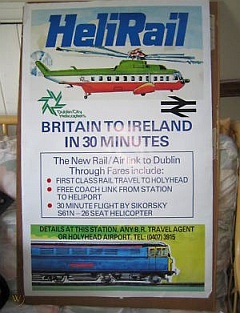
Forthcoming events
(see also our Calendar page for venues)
Note: we have removed all entries relating to meetings as the events are cancelled.
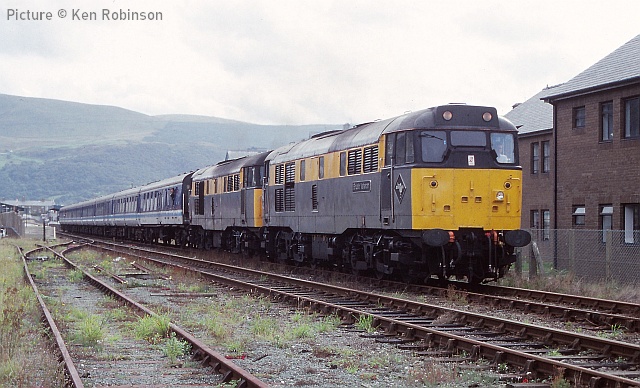
On 12 September 1992, 31 146 Brush Veteran and 31 147 (not confirmed) departing Barmouth with the 09:25 Birmingham New Street - Pwllheli. Picture by Ken Robinson.
From Dave Sallery's archive
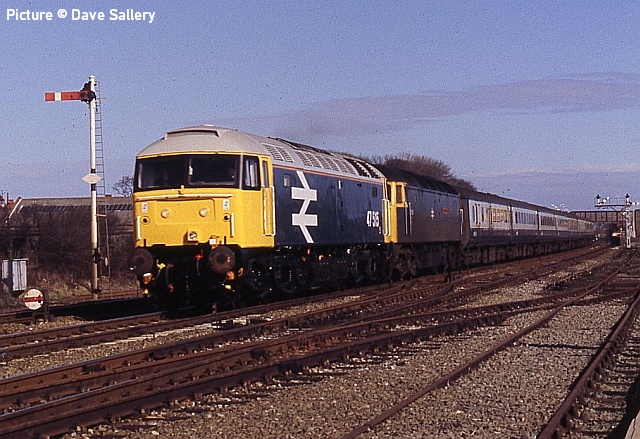
Prestatyn on 5 March 1986, before the track layout was 'rationalised'. 47 515 is on test after overhaul at Crewe works, attached to the front of what looks like a train from London to Holyhead hauled by 47 535 University of Leicester. 47 515, as D1961, built 1968, was the last member of the class to be built at Brush Falcon Works, later examples being built by BR at Crewe.
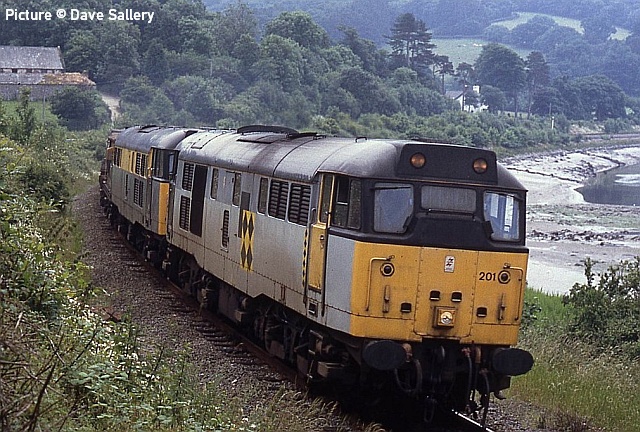
On 1 July 1994, 31 201 and 31 163 pass Tal-y-Cafn on the Conwy Valley branch with nuclear flasks from Trawsfynydd.
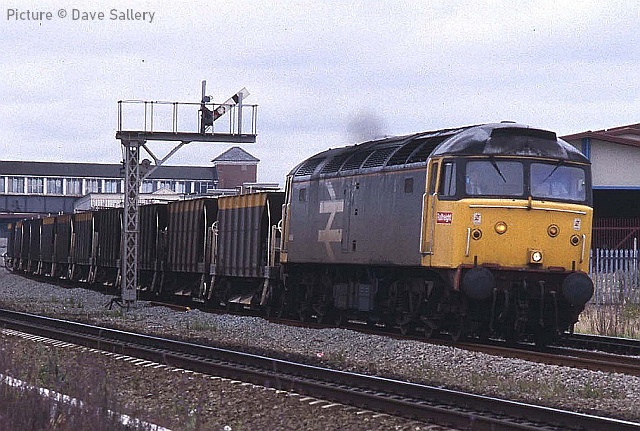
Not-so-sunny Rhyl on 19 July 1991, 47 356 on another load of ballast from Penmaenmawr.
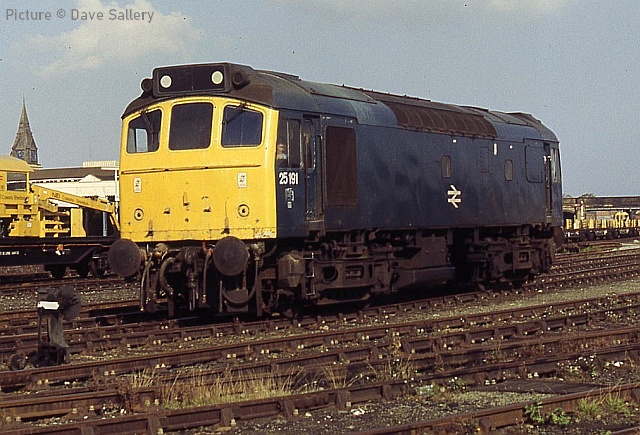
On 12 October 1986, 25 191 pauses in Rhyl yard, which has several sidings for stabling of rolling stock as well as a goods facility. The station footbridge can be glimpsed in the distance. Soon after this picture was taken, the whole layout was closed and lifted, replaced by the supermarket and car park that occupy the space today. The store was originally a co-op 'Leo's' operation, later called Pioneer, and in 2000 taken over by Morrison's (see the Rhyl Life website).
At one time (when 37s were found on passenger trains?) it was possible to reach the store directly from the Down platform of the adjacent station, a useful feature for hungry railfans engaged in quick-turnround train ride, but later the gate was locked and a long roundabout walk needed.
25 191 had an interesting career, summarised in an interesting article on the Derby Sulzers website. It was, however, decided to phase out the 25s and replace them with 31s transferred from elsewhere, which were just as old but had been re-engined during their early life. 191 was withdrawn on 18 March 1987, but saved for preservation. Initially it worked on the North York Moors line, but now appears to be 'awaiting overhaul' at the South Devon Railway.
Helirail
In the 13 October issue we featured the one-way Holyhead to London sleeping-car service which ran in the 1980s. However, this was not always the case, as John Dawson, former Public Relations Manager BR London Midland Region, writes to remind us.
For about 6 weeks in Spring 1985 the sleeping car ran from Euston (dep 22:00) in connection with 'Helirail' – the helicopter service from Holyhead to Dublin run by Dublin City Helicopters. The inaugural run conveying a press party ran from Euston on 1 April 1985 with the launch of the helicopter service by TV personality Anneka Rice on the morning of 2 April. The service only lasted a few weeks and the sleeper was then withdrawn again. See the poster in the left column.
RHTT at Mostyn
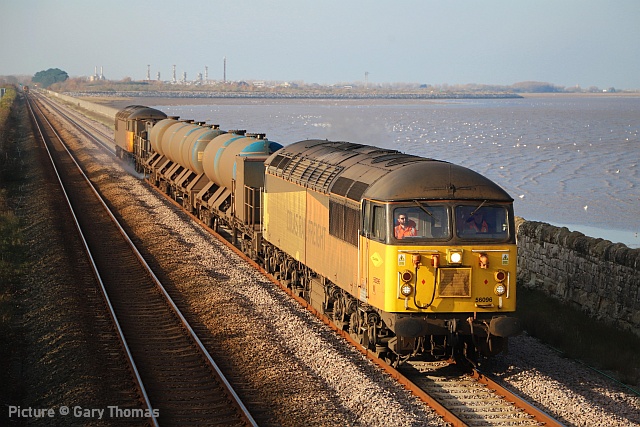
56 096 (above) and 56 113 (below) ply their trade on the Rail Head Treatment Train, 6 November (Gary Thomas).
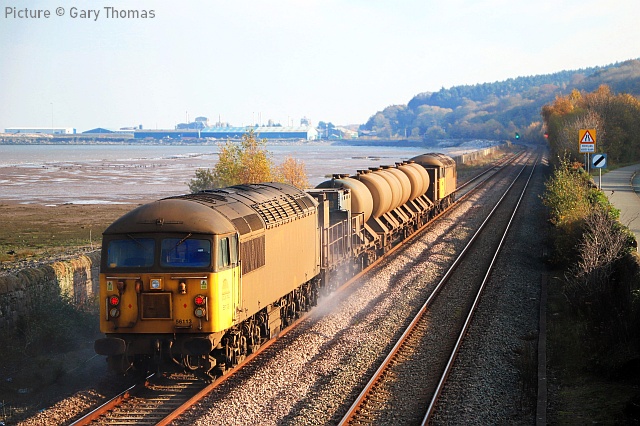
A day in 2004 - and a new DVD - by John Wilkinson
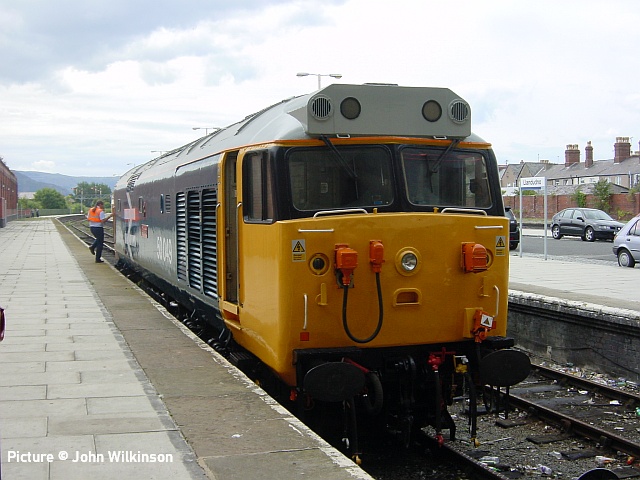
Some images from a day's filming on 19 July 2004. The story, as much as I know (there is bound to be someone who knows all the facts.)
47 750 had been put in the yard by Llandudno Junction station as it was a failure earlier in the month. On the day, 50 031 Hood and 50 049 Defiance came from Kidderminster and arrived 12:37 at Llandudno Junction. Both locos then entered the yard.
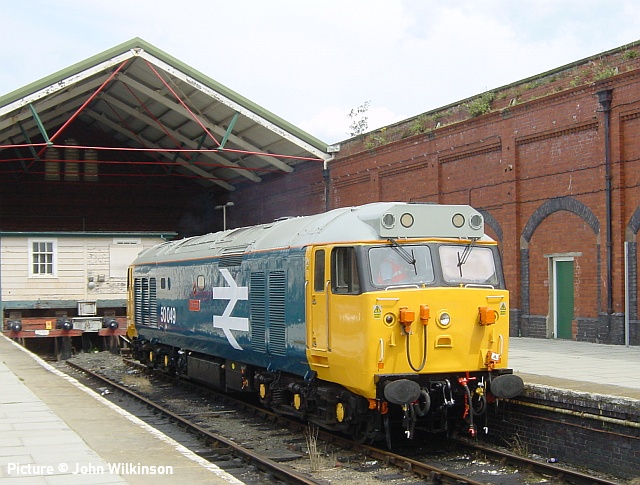
50 049 then went to Llandudno solo and I filmed it at Deganwy at 13:05. I filmed it there (above).
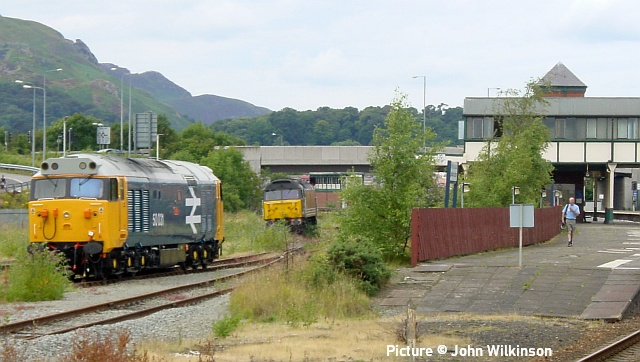
Back at the Junction, 50 031 was coupled to one end of 47 750 ...
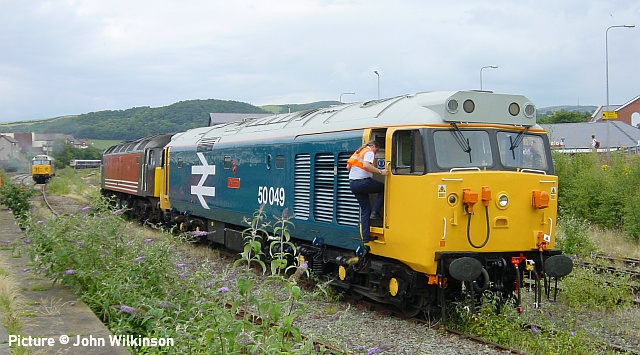
... and 50049 on the other.
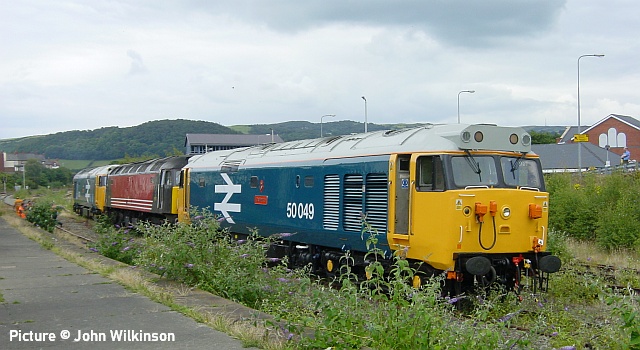
In top-and-tail mode they left The Junction at 15:25. I left and filmed the ensemble going through Helsby Junction at 16:28. A day's filming with a difference sixteen years ago.
A new DVD, 'British Rail Motive Power 1981-1999 volume 6', featuring footage by John Wilkinson, is now available from the publishers of the well-received video 'North Wales Coast 37 Farewell, and among other delights covers North Wales Coast scenes from 1999, and the Conwy Crusader Railtour of April 1982.
The new arrangements for railways in Wales
Here's an extract from a statement made by Ken Skates MS Minister for Economy and Transport, to the Senedd on 3 November about the future of Welsh rail services:
Transport for Wales have now agreed the fundamentals of a new relationship between themselves and Keolis and Amey, which will provide a new robust delivery model. We are taking the urgent action necessary to protect services, to safeguard jobs and to deliver the ambitious metro programme. At this point, though, I do need to emphasise that we are still negotiating the particulars of the contract with our partners, so I'm sure Members will understand that I can't be too specific about commercially sensitive details at this stage.The full statement, and questions raised by other members can be found on the Senedd website.
The rail services that passengers use will, from February of next year, be operated by a new publicly owned subsidiary of Transport for Wales. The new publicly owned company has obtained its own safety licence and will be subject to safety and other regulation by the Office of Rail and Road, in exactly the same way as all other rail operators. We're taking public sector control over the day-to-day operation and delivery of rail services, to balance the need for best value for money for the taxpayer and to ensure the continuation of our vital rail services.
As well as protecting the delivery of rail services, we have also taken steps to secure the continued transformation of the core Valleys lines and ensure the building of the south Wales metro. This work will continue to be delivered by Amey Keolis Infrastructure Ltd, and a new partnership with KeolisAmey, led by Transport for Wales, will be established to help with the delivery of important commitments such as integrated ticketing and the ongoing integration of light and heavy rail. This is a necessary step that we have to take now to ensure the stability and ongoing operation of our rail services. We will continue to operate our rail services in this way, with our new public sector delivery model, for the foreseeable future.
The very long train - recalled by Marc Thomas
This is a film I took in 2016 on the railway bridge down near the estuary at Llandudno Junction. Having just watched the most recent edition of 'Paddington' on Channel 5 TV and seen the exact same train, it reminded me that I'd filmed it later in an evening four years ago. I can't get over how long the train was, half a mile in length supposedly.
[For details of the train, see our 24 June 2016 issue.]
Alan Cliff
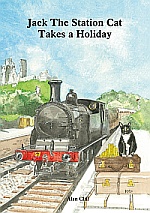 The Reverend Alan Cliff, a
well-known resident of Rhyl since 1987, whose 'Jack the
Station Cat' story books (illustrated by his son
Nigel) gave pleasure to many and also raised money for
many charities, has died, aged 84 after a long illness. A
life-long rail enthusiast and modeller, he also wrote many
articles for model railway magazines. At one time he
owned Hunslet quarry locomotive Holy War
which now lives at Bala Lake Railway. There's a full obituary
in the Rhyl Journal, and there is now an online shop selling
his books: at £2.95 post free, an excellent 'stocking
filler' we'd suggest, suitable for children aged 3-9.
The Reverend Alan Cliff, a
well-known resident of Rhyl since 1987, whose 'Jack the
Station Cat' story books (illustrated by his son
Nigel) gave pleasure to many and also raised money for
many charities, has died, aged 84 after a long illness. A
life-long rail enthusiast and modeller, he also wrote many
articles for model railway magazines. At one time he
owned Hunslet quarry locomotive Holy War
which now lives at Bala Lake Railway. There's a full obituary
in the Rhyl Journal, and there is now an online shop selling
his books: at £2.95 post free, an excellent 'stocking
filler' we'd suggest, suitable for children aged 3-9.Chester to Crewe 1950s - from the collection of Dave Stewart
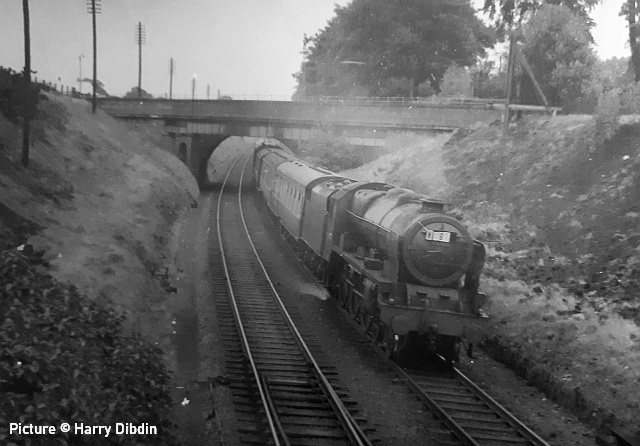
When I was a kid, around 1968-69, I was given these prints by the regular signalman at Waverton signalbox. He said that they were in the ‘box when he started there, and as the ‘box was likely to close soon and he wasn’t particularly interested, he thought that I should have them. He mentioned that they were taken by a predecessor - Harry Dibdin, who was the co-author of 'Trams and Buses of the City of Chester' (1979). The captions show any details that are written on the reverse of the photos and I have added a few more details of my own.
Above, on 20 August 1955, at Christeton, north from Waverton. The train, which is heading north and hauled by what I think is a rebuilt ‘Patriot’, is passing under the bridge carrying the A41 trunk road over the line and will then enter the tunnel under the canal. The crossover in the foreground and the down home signal over the bridge were controlled by Christleton ‘box which I understand contained just five levers.
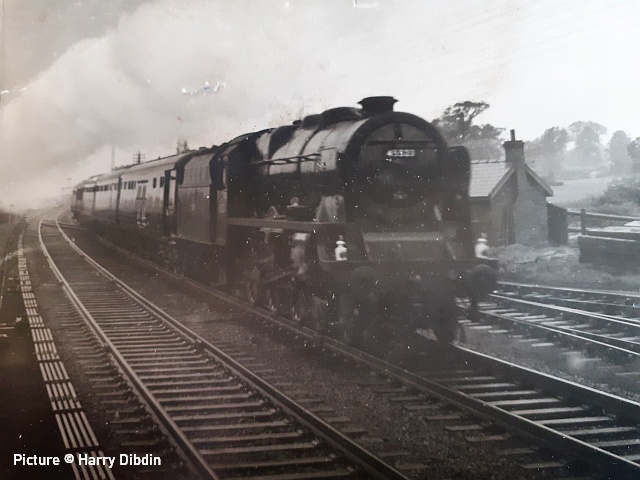
28 May 1954: ‘Royal Train conveying Princess Margaret from Chester to London passing Waverton at 3.39 pm with Loco 45523 Bangor.' The Princess visited Eaton Hall Officer Cadet School at Eccleston in May 1954; however the train is not showing the traditional four-headlamp Royal headcode. ‘Photo by HG Dibdin…..(Heavy ?) rain and cloud 1/100 sec) This seems to be taken from the steps of Waverton ‘box, which was situated just beyond the north end of the down platform.
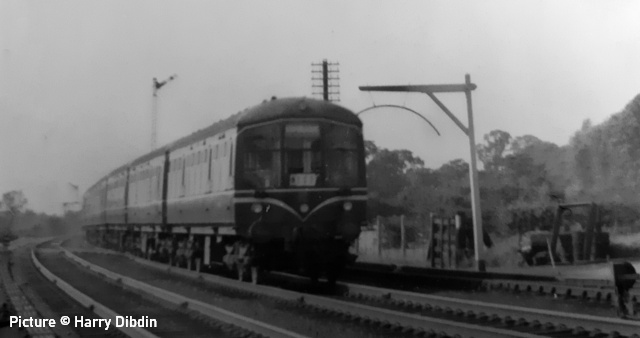
No details on the print. Several first generation ‘Derby Lightweight’ DMUs in multiple in the same location at Waverton, heading to Crewe. The headcode in the window suggests an excursion.
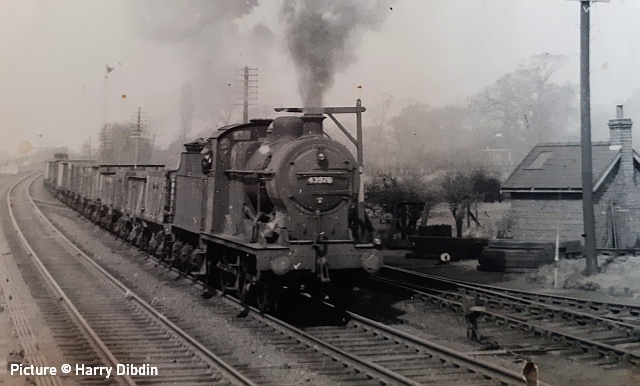
Fowler ‘4F’ No 43976 on a freight train.
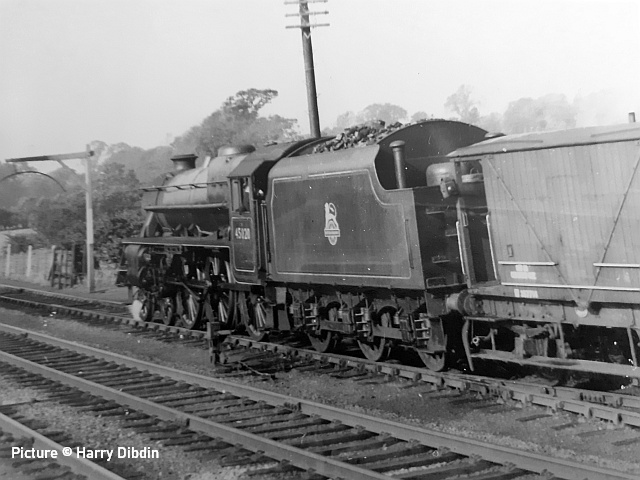
9 October 1954: ‘45020 at Waverton’. There were two sidings at Waverton plus a short cattle dock which were accessed by a trailing connection from the down line. There was also a trailing connection from the up line into the shunting neck, which are the points under the brake van. The shunting signal seen was, at least in 1969, a yellow bar on a black background. In the ‘off’ position this allowed access to the mainline, but otherwise could be passed but only to access the sidings.
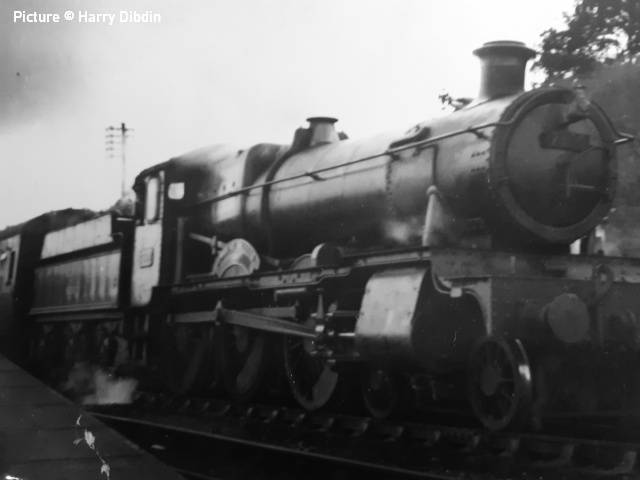
6 August 1954: ‘7800 “Torquay Manor” at Bala Junction on a Barmouth train’.
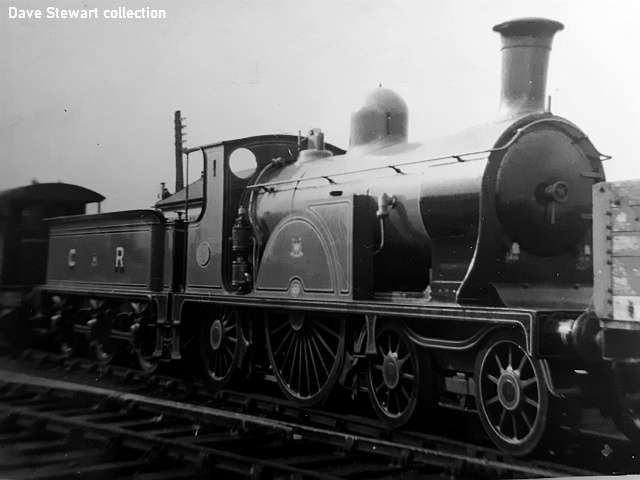
‘CR 123 24/7/53 Waverton’: This is, of course, the unique 4-2-2 built by Neilson and Company for the Caledonian Railway in 1886 which earned fame in the Race to the North of August 1888, allowing the West Coast companies to win, and which is currently a static exhibit at the Riverside Museum in Glasgow. Waverton Signalbox can be seen behind the cab of the loco in the first photo. It was a standard LNWR structure with 19 levers.
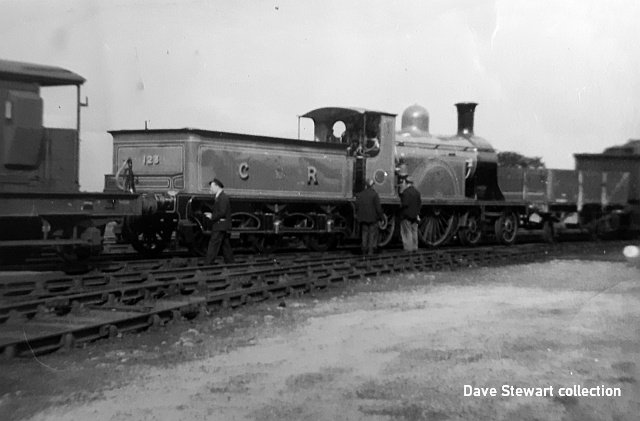
The sidings at Waverton could be used for refuge purposes for short trains so that could explain why the loco is there, possibly to check that all is well. It had been part of the 'Royal Journey' exhibition train which toured various main stations in 1953 to celebrate the Coronation, perhaps it was returing home to Glasgow. The handwriting appears to be different on the reverse of these two photos so I'm unsure if they are from the same source.
Waverton station closed to passengers in 1959 but coal traffic for a local merchant kept the sidings and therefore the signalbox open until, I think, early 1970, after which it was soon demolished. The Up-side building and LNW timber goods shed remain.
Note: Any copyright owners of the Dibdin images are invited to contact us.
Looking back : Talyllyn Railway, Part 1 - with David Pool
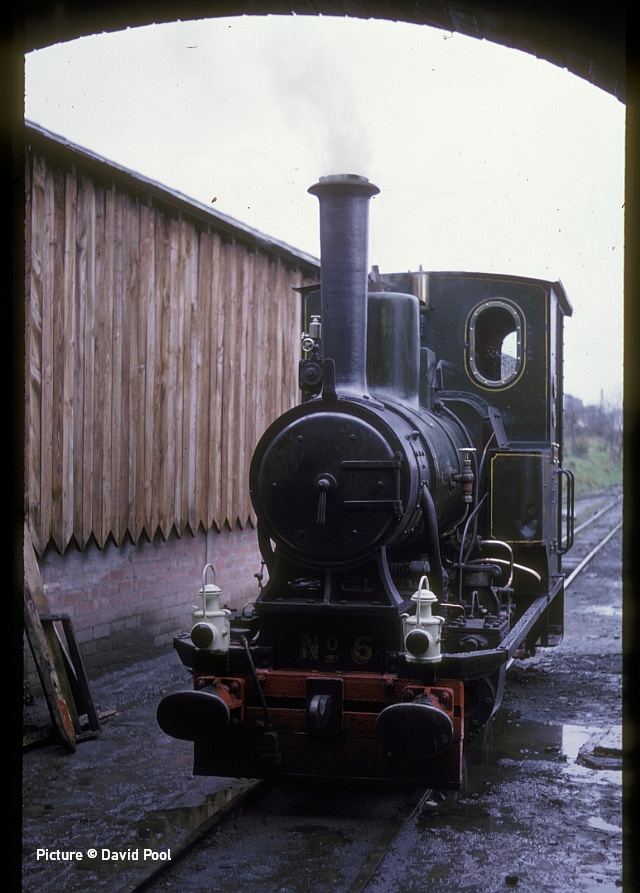
In 1953 a locomotive from the narrow gauge system at RAF Calshot was donated to the Talyllyn Railway. After being regauged from 2 foot to 2 feet 3 inches it was named Douglas, after its donor. On my visit to Pendre shed on 14 April 1963 it was being made ready for the day’s trains. Douglas was built by Andrew Barclay in 1918, and is No.6 in the Talyllyn fleet.
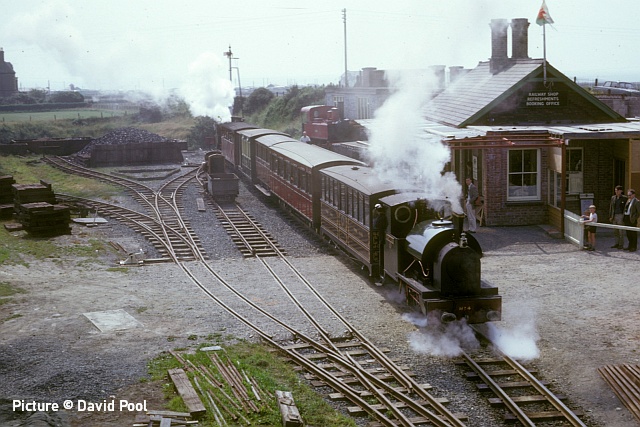
The most popular location for photographing Talyllyn trains is from the road bridge overlooking Wharf station in Tywyn (or Towyn as it was previously). On 17 July 1965 the afternoon train was being hauled by one of the two locomotives obtained in 1951 when the Corris Railway closed. Corris No.4, built by Kerr Stuart in 1921, was now named Edward Thomas, retaining its number, and had been fitted with a Giesl ejector and modified chimney in 1958.
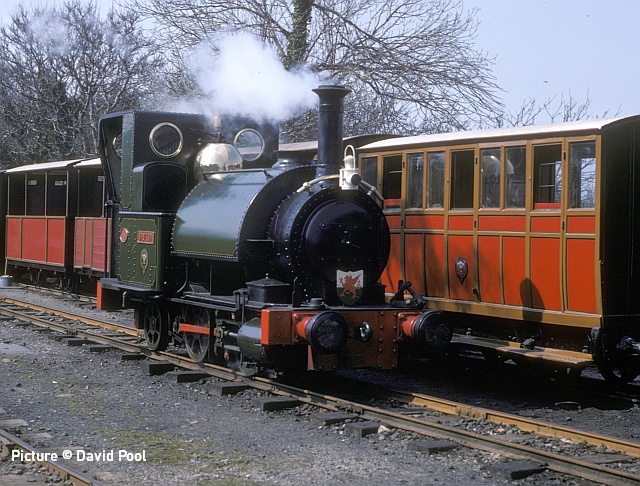
No. 1 Talyllyn was one of the two original locomotives on the Talyllyn Railway, being built by Fletcher, Jennings & Co. in 1864. It was photographed at Pendre on 15 April 1968. No. 1 was somehow kept going in the early days of preservation, but eventually was given a well deserved major overhaul, and reliability issues were finally overcome.
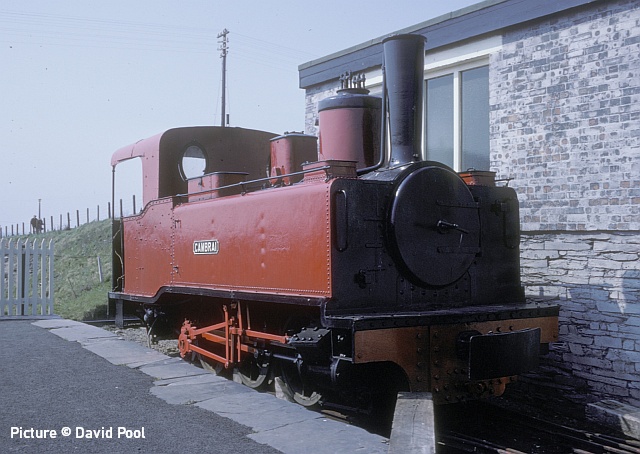
On 15 April 1968 it was rather strange to see a large French metre gauge locomotive on the platform at Wharf station, outside the Museum dedicated to the narrow gauge. I have always assumed it was too large to fit in the Museum, and could not be a candidate for regauging, so perhaps it was just being rescued until a more appropriate home could be found. Cambrai was built by Corpet Louvet in 1888 for the Chemin de Fer du Cambresis, where it ran as No. 5 until 1936. From there it went to the Loddington Tramway near Kettering, moving in 1956 to another tramway in Leicestershire, and finally arriving at Towyn in 1960.
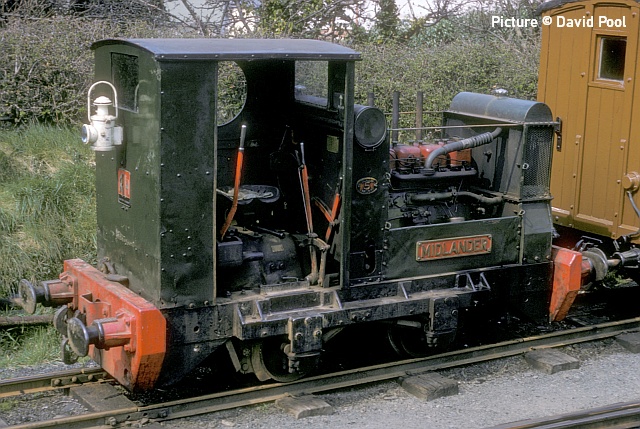
The diesel locomotives on steam railways are usually out of the limelight, and on the same day I found Talyllyn No. 5 outside Pendre shed. This was Midlander, a Ruston Hornby diesel built in 1940, and used exclusively on Works trains. It was later rebuilt and re-engined in 1980.
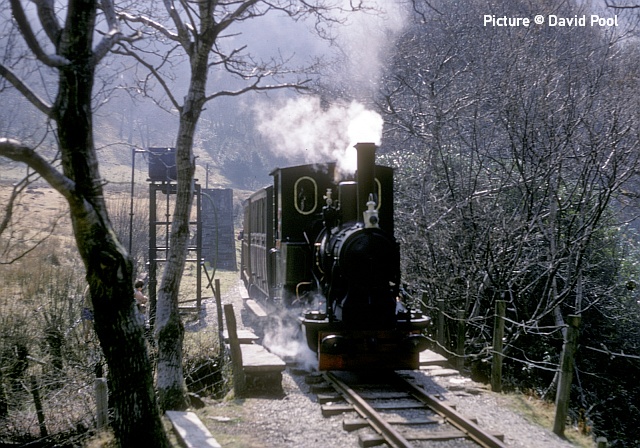
The water tank near Dolgoch Falls often appears in photographs of the Talyllyn, but this location is particularly difficult in view of the overhanging trees and the position of the sun for most of the day. My shot of No. 6 Douglas on 7 April 1969 was as good as I was able to get in the circumstances.
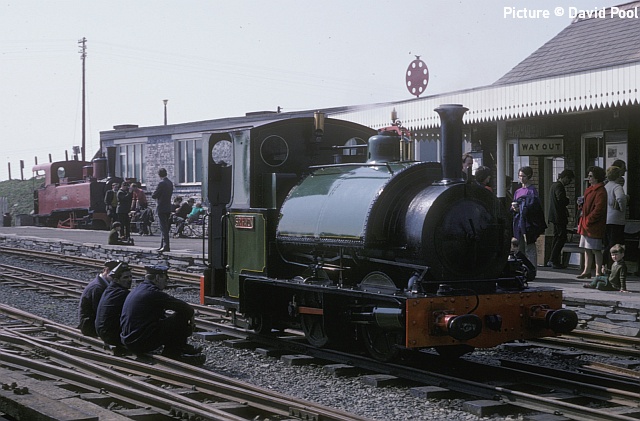
The other Corris locomotive No. 3 Sir Haydn was built by Hughes at the Falcon Works in 1878, and has spent most of the time since 1961 at the Talyllyn. The unusual gauge of 2 feet 3 inches means that there are few opportunities to see it working on other preserved lines, although at one time it was stored at Corris and later exhibited at other preserved railways in order to raise fund for an overhaul. On 7 April 1969 it was at Wharf station with an afternoon train.
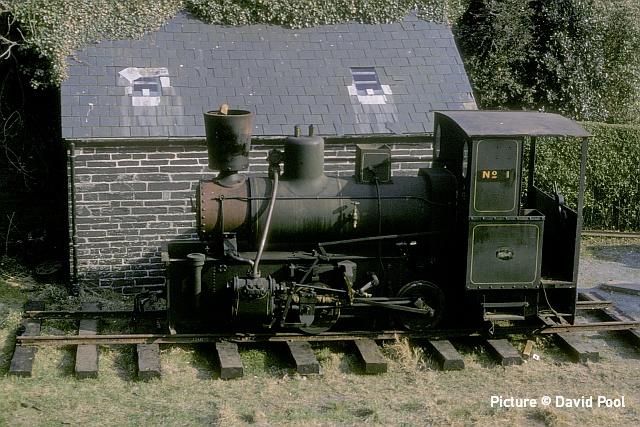
On the same day I was pleased to find another visitor at Wharf station. The 3 foot gauge Andrew Barclay locomotive from Bord na Mona (the operators of the peat railways in Ireland) had been acquired to supplement the Talyllyn motive power, although it would need a gauge change. Unofficially named Irish Pete, it was eventually rebuilt in 1991 and named Tom Rolt, who was one of the founders of the Talyllyn Railway Preservation Society.
Special Diesel Excursion
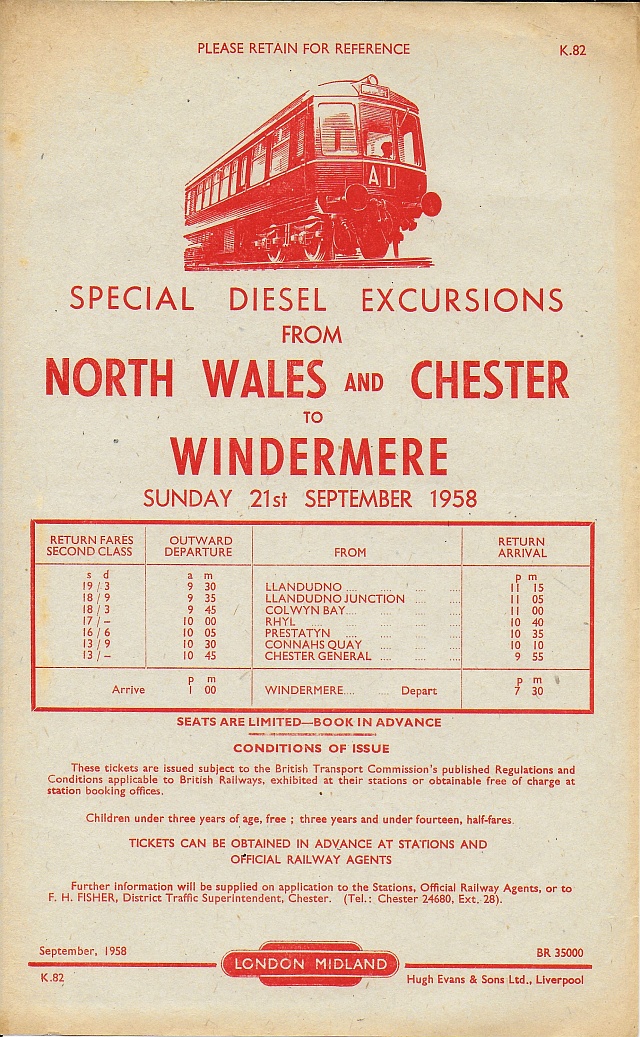
Following the item about the 'Green Express' excursion fdrom North Wales in the last issue, here is a handbill (from Mark Hambly's collection) with another example of an outward excursion, this time from Llandudno to Windermere in September 1958. Very late in the holiday season, perhaps the market was all the 'hospitality' workers who had been working hard all summer.
The diesel railcars were a great attraction to passengers at the time, their airy interiors and good view, including from the front, made them a much better environment than their stea-hauled predecessors. The illustration shows one of the 'Derby heavyweight' units built for the Eastern Region in 1956; the similar and more common Class 108s never had the roof-mounted headlamp, perhaps intended to show the steam-age 'headlamp code' for a stopping passenger train.
The 'London Midland' on the totem is an indication that the London Midland Region at that time liked to think of itself as a separate railway company.
North Wales Coast home page | Archive | Previous Notice Board